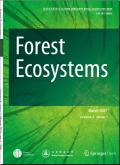Updating the distribution of Nothofagus alessandrii: Impact of deforestation, fragmentation and connectivity
IF 3.8
1区 农林科学
Q1 FORESTRY
引用次数: 0
Abstract
Nothofagus alessandrii forests in the Mediterranean region of Chile face significant threats from deforestation, fragmentation, wildfires, and climate change. This study investigated the temporal and spatial dynamics of N. alessandrii populations and their implications for habitat fragmentation and connectivity. Using remote sensing data and geographic information system analysis, we assessed deforestation patterns, fragmentation metrics, and connectivity indices for different scenarios between 2009 and 2022. A reduction in the N. alessandrii forest area, extensive fragmentation, and decreased connectivity were observed over time, with wildfires exacerbating these trends. Reforestation simulations showed the potential of targeted restoration efforts to improve connectivity, especially when focusing on proximate patches. However, careful consideration of seed dispersal distances and wildfire risk is essential for effective reforestation planning. Overall, our findings underscore the urgent need for conservation interventions to preserve N. alessandrii forests and their biodiversity in Chile's coastal mountain ecosystems. A proactive and collaborative approach is essential to ensure the survival of these forests for future generations.
求助全文
约1分钟内获得全文
求助全文
来源期刊

Forest Ecosystems
Environmental Science-Nature and Landscape Conservation
CiteScore
7.10
自引率
4.90%
发文量
1115
审稿时长
22 days
期刊介绍:
Forest Ecosystems is an open access, peer-reviewed journal publishing scientific communications from any discipline that can provide interesting contributions about the structure and dynamics of "natural" and "domesticated" forest ecosystems, and their services to people. The journal welcomes innovative science as well as application oriented work that will enhance understanding of woody plant communities. Very specific studies are welcome if they are part of a thematic series that provides some holistic perspective that is of general interest.
 求助内容:
求助内容: 应助结果提醒方式:
应助结果提醒方式:


